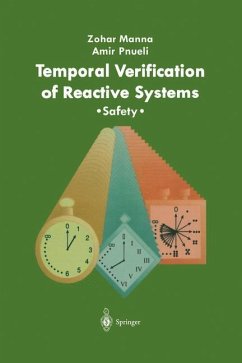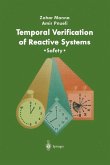This book presents an extensive verification methodology for proving that reactive systems meet their specifications, expressed as safety properties in the language of temporal logic. The methods include deductive approaches based on theorem proving and fully automatic approaches based on model checking. All researchers and students interested in the analysis and verification of reactive and concurrent systems will find this book to be a comprehensive guide on how formal techniques can be used to ensure the correctness of such systems. An educational version of the Stanford Temporal Prover (STeP), a tool which supports the verification of reactive systems, is available for use with this book.
This book is about the verification of reactive systems. A reactive system is a system that maintains an ongoing interaction with its environment, as opposed to computing some final value on termination. The family of reactive systems includes many classes of programs whose correct and reliable construction is con sidered to be particularly challenging, including concurrent programs, embedded and process control programs, and operating systems. Typical examples of such systems are an air traffic control system, programs controlling mechanical devices such as a train, or perpetually ongoing processes such as a nuclear reactor. With the expanding use of computers in safety-critical areas, where failure is potentially disastrous, correctness is crucial. This has led to the introduction of formal verification techniques, which give both users and designers of software and hardware systems greater confidence that the systems they build meet the desired specifications. Framework The approach promoted in this book is based on the use of temporal logic for specifying properties of reactive systems, and develops an extensive verification methodology for proving that a system meets its temporal specification. Reactive programs must be specified in terms of their ongoing behavior, and temporal logic provides an expressive and natural language for specifying this behavior. Our framework for specifying and verifying temporal properties of reactive systems is based on the following four components: 1. A computational model to describe the behavior of reactive systems. The model adopted in this book is that of a Fair Transition System (FTS).
This book is about the verification of reactive systems. A reactive system is a system that maintains an ongoing interaction with its environment, as opposed to computing some final value on termination. The family of reactive systems includes many classes of programs whose correct and reliable construction is con sidered to be particularly challenging, including concurrent programs, embedded and process control programs, and operating systems. Typical examples of such systems are an air traffic control system, programs controlling mechanical devices such as a train, or perpetually ongoing processes such as a nuclear reactor. With the expanding use of computers in safety-critical areas, where failure is potentially disastrous, correctness is crucial. This has led to the introduction of formal verification techniques, which give both users and designers of software and hardware systems greater confidence that the systems they build meet the desired specifications. Framework The approach promoted in this book is based on the use of temporal logic for specifying properties of reactive systems, and develops an extensive verification methodology for proving that a system meets its temporal specification. Reactive programs must be specified in terms of their ongoing behavior, and temporal logic provides an expressive and natural language for specifying this behavior. Our framework for specifying and verifying temporal properties of reactive systems is based on the following four components: 1. A computational model to describe the behavior of reactive systems. The model adopted in this book is that of a Fair Transition System (FTS).










